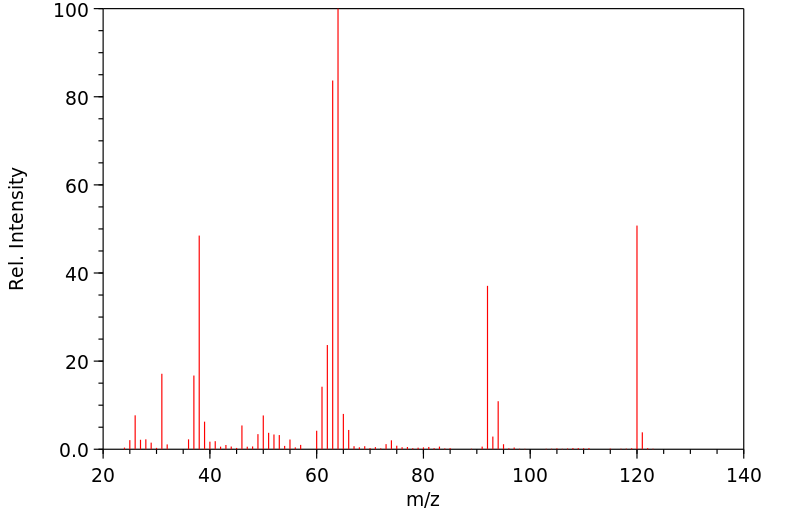4-二氮醌 | 932-97-8
中文名称
4-二氮醌
中文别名
——
英文名称
4-diazo-2,5-cyclohexadienone
英文别名
4-diazocyclohexa-2,5-dien-1-one;p-Benzochinondiazid;3-Diazo-cyclohexadien-(1.4)-on-(6);p-Diazoquinone;4-diazoniophenolate
CAS
932-97-8
化学式
C6H4N2O
mdl
MFCD01734497
分子量
120.111
InChiKey
WTQZSMDDRMKJRI-UHFFFAOYSA-N
BEILSTEIN
——
EINECS
——
-
物化性质
-
计算性质
-
ADMET
-
安全信息
-
SDS
-
制备方法与用途
-
上下游信息
-
文献信息
-
表征谱图
-
同类化合物
-
相关功能分类
-
相关结构分类
物化性质
-
熔点:87 °C (decomp)(Solv: ethyl ether (60-29-7))
计算性质
-
辛醇/水分配系数(LogP):2.9
-
重原子数:9
-
可旋转键数:0
-
环数:1.0
-
sp3杂化的碳原子比例:0.0
-
拓扑面积:51.2
-
氢给体数:0
-
氢受体数:2
SDS
上下游信息
-
上游原料
中文名称 英文名称 CAS号 化学式 分子量 对氨基苯酚 4-amino-phenol 123-30-8 C6H7NO 109.128
反应信息
-
作为反应物:参考文献:名称:芳族氟化物的制备:使用吡啶-n HF轻松进行光诱导的苯二氮杂鎓盐及其相关化合物的氟化分解摘要:通过使用吡啶-n HF溶液,已成功地进行了苯二氮杂鎓盐(ArN 2 BF 4)(氟脱重氮)和相关化合物(如醌二叠氮化物和三氮烯)的光致氟化分解,以生产相应的芳族氟化物(ArF)的高收益率。吡啶-n HF溶液中对位取代ArN 2 BF 4的氟脱氮反应速率不符合经典的Hammett方程,但与塔夫脱(Taft)的处理方法[双取代基参数关系(DSP)]很好地吻合。ArN 2 BF 4的热氟脱氮中反应速率受底物中取代基的影响很大。相反,仅观察到取代基对ArN 2 BF 4的光诱导的氟脱氮反应的速率有轻微的影响。DOI:10.1016/s0022-1139(99)00039-1
-
作为产物:描述:参考文献:名称:Hantzsch; Davidson, Chemische Berichte, 1896, vol. 29, p. 1533摘要:DOI:
文献信息
-
Chemoselective Rearrangement Reactions of Sulfur Ylide Derived from Diazoquinones and Allyl/Propargyl Sulfides作者:Sijia Yan、Junxin Rao、Cong-Ying ZhouDOI:10.1021/acs.orglett.0c03493日期:2020.11.20three types of rearrangement reactions of sulfur ylide derived from diazoquinones and allyl/propargyl sulfides. With Rh2(esp)2 as the catalyst, diazoquinones react with allyl/propargyl sulfides to form a sulfur ylide, which undergoes a chemoselective tautomerization/[2,3]-sigmatropic rearrangement reaction, a Doyle–Kirmse rearrangement/Cope rearrangement cascade reaction, or a Doyle–Kirmse rearrangement/elimination
-
Heavy-Atom Tunneling in the Ring Opening of a Strained Cyclopropene at Very Low Temperatures作者:Melanie Ertelt、David A. Hrovat、Weston Thatcher Borden、Wolfram SanderDOI:10.1002/chem.201303792日期:2014.4.140]‐hexa‐3,5‐dien‐2‐one 1 is metastable, and rearranges to 4‐oxacyclohexa‐2,5‐dienylidene 2 in inert gas matrices (neon, argon, krypton, xenon, and nitrogen) at temperatures as low as 3 K. The kinetics for this rearrangement show pronounced matrix effects, but in a given matrix, the reaction rate is independent of temperature between 3 and 20 K. This temperature independence means that the activation高度应变的1H-双环[3.1.0] -hexa-3,5-dien-2-one 1是亚稳态的,并重排为4-oxacyclohexa-2,5-dienylidene 2在惰性气体基质(氖气,氩气,k气,氙气和氮气)中的温度低至3K。这种重排的动力学表现出明显的基质效应,但是在给定的基质中,反应速率与温度在3至30之间无关。 20K。这种温度无关性意味着在此温度范围内活化能为零,这表明反应是通过从反应物的最低振动能级进行的量子力学隧穿来进行的。在高于20 K的温度下,速率增加,导致弯曲的Arrhenius曲线也表明热激活隧穿。这些实验结果得到了使用小曲率隧穿(SCT)近似在CASSCF和CASPT2级别进行的计算的支持。
-
Cp*Rh(<scp>iii</scp>) and Cp*Ir(<scp>iii</scp>)-catalysed redox-neutral C–H arylation with quinone diazides: quick and facile synthesis of arylated phenols作者:Shang-Shi Zhang、Chun-Yong Jiang、Jia-Qiang Wu、Xu-Ge Liu、Qingjiang Li、Zhi-Shu Huang、Ding Li、Honggen WangDOI:10.1039/c5cc03187g日期:——
Cp*Rh(
iii )- and Cp*Ir(iii )-catalysed direct C–H arylation with quinone diazides provides a facile and redox-neutral access to arylated phenols. -
An Efficient Procedure for the Synthesis of Crystalline Aryldiazonium Trifluoroacetates – Synthetic Applications作者:Christophe Colas、Maurice GoeldnerDOI:10.1002/(sici)1099-0690(199906)1999:6<1357::aid-ejoc1357>3.0.co;2-p日期:1999.6spectra have been recorded for all the synthesized salts; the data are in good agreement with the rather limited published data and constitute a first extensive report of 13C-NMR chemical shifts in diazonium salts. An excellent linear relationship emerged between Brown's substituent constants s+p and the 13Cipso chemical shifts. The diazonium salts obtained proved to be much more soluble in organic我们开发了一种非常温和的方法,用于在无水条件下以高产率合成结晶芳基重氮三氟乙酸盐。超过 30 种单官能或多官能苯胺衍生物已通过这种方法重氮化,包括对水和酸敏感的底物。衍生自相应苯胺的邻和对羟基芳基重氮盐可以通过用 K2CO3 处理去质子化以产生纯的重氮醌。已记录所有合成盐的 NMR 和 UV/Vis 光谱;这些数据与相当有限的公开数据非常吻合,并构成了重氮盐中 13C-NMR 化学位移的第一份广泛报告。Brown 的取代基常数 s+p 和 13Cipso 化学位移之间出现了极好的线性关系。获得的重氮盐证明比它们的四氟硼酸盐对应物更易溶于有机溶剂。它们在各种碳-碳双键的 Pd 介导的偶联反应中进行了测试,发现在非常温和的条件下,在很短的反应时间内获得了良好的产率。我们相信重氮三氟乙酸盐是重氮四氟硼酸盐的一种非常有吸引力的替代品。
-
Quinone Diazides for Olefin Functionalization作者:Hai T. Dao、Phil S. BaranDOI:10.1002/anie.201408022日期:2014.12.22potentially useful motif has languished in the annals of organic synthesis. Herein we show that modern tools of catalysis can be employed with free or suitably masked quinone diazides to unleash the power of these classic diazo compounds in the context of both inter‐ and intramolecular olefin cyclopropanation.
表征谱图
-
氢谱1HNMR
-
质谱MS
-
碳谱13CNMR
-
红外IR
-
拉曼Raman
-
峰位数据
-
峰位匹配
-
表征信息
同类化合物
(βS)-β-氨基-4-(4-羟基苯氧基)-3,5-二碘苯甲丙醇
(S,S)-邻甲苯基-DIPAMP
(S)-(-)-7'-〔4(S)-(苄基)恶唑-2-基]-7-二(3,5-二-叔丁基苯基)膦基-2,2',3,3'-四氢-1,1-螺二氢茚
(S)-盐酸沙丁胺醇
(S)-3-(叔丁基)-4-(2,6-二甲氧基苯基)-2,3-二氢苯并[d][1,3]氧磷杂环戊二烯
(S)-2,2'-双[双(3,5-三氟甲基苯基)膦基]-4,4',6,6'-四甲氧基联苯
(S)-1-[3,5-双(三氟甲基)苯基]-3-[1-(二甲基氨基)-3-甲基丁烷-2-基]硫脲
(R)富马酸托特罗定
(R)-(-)-盐酸尼古地平
(R)-(-)-4,12-双(二苯基膦基)[2.2]对环芳烷(1,5环辛二烯)铑(I)四氟硼酸盐
(R)-(+)-7-双(3,5-二叔丁基苯基)膦基7''-[((6-甲基吡啶-2-基甲基)氨基]-2,2'',3,3''-四氢-1,1''-螺双茚满
(R)-(+)-7-双(3,5-二叔丁基苯基)膦基7''-[(4-叔丁基吡啶-2-基甲基)氨基]-2,2'',3,3''-四氢-1,1''-螺双茚满
(R)-(+)-7-双(3,5-二叔丁基苯基)膦基7''-[(3-甲基吡啶-2-基甲基)氨基]-2,2'',3,3''-四氢-1,1''-螺双茚满
(R)-(+)-4,7-双(3,5-二-叔丁基苯基)膦基-7“-[(吡啶-2-基甲基)氨基]-2,2”,3,3'-四氢1,1'-螺二茚满
(R)-3-(叔丁基)-4-(2,6-二苯氧基苯基)-2,3-二氢苯并[d][1,3]氧杂磷杂环戊烯
(R)-2-[((二苯基膦基)甲基]吡咯烷
(R)-1-[3,5-双(三氟甲基)苯基]-3-[1-(二甲基氨基)-3-甲基丁烷-2-基]硫脲
(N-(4-甲氧基苯基)-N-甲基-3-(1-哌啶基)丙-2-烯酰胺)
(5-溴-2-羟基苯基)-4-氯苯甲酮
(5-溴-2-氯苯基)(4-羟基苯基)甲酮
(5-氧代-3-苯基-2,5-二氢-1,2,3,4-oxatriazol-3-鎓)
(4S,5R)-4-甲基-5-苯基-1,2,3-氧代噻唑烷-2,2-二氧化物-3-羧酸叔丁酯
(4S,4''S)-2,2''-亚环戊基双[4,5-二氢-4-(苯甲基)恶唑]
(4-溴苯基)-[2-氟-4-[6-[甲基(丙-2-烯基)氨基]己氧基]苯基]甲酮
(4-丁氧基苯甲基)三苯基溴化磷
(3aR,8aR)-(-)-4,4,8,8-四(3,5-二甲基苯基)四氢-2,2-二甲基-6-苯基-1,3-二氧戊环[4,5-e]二恶唑磷
(3aR,6aS)-5-氧代六氢环戊基[c]吡咯-2(1H)-羧酸酯
(2Z)-3-[[(4-氯苯基)氨基]-2-氰基丙烯酸乙酯
(2S,3S,5S)-5-(叔丁氧基甲酰氨基)-2-(N-5-噻唑基-甲氧羰基)氨基-1,6-二苯基-3-羟基己烷
(2S,2''S,3S,3''S)-3,3''-二叔丁基-4,4''-双(2,6-二甲氧基苯基)-2,2'',3,3''-四氢-2,2''-联苯并[d][1,3]氧杂磷杂戊环
(2S)-(-)-2-{[[[[3,5-双(氟代甲基)苯基]氨基]硫代甲基]氨基}-N-(二苯基甲基)-N,3,3-三甲基丁酰胺
(2S)-2-[[[[[((1S,2S)-2-氨基环己基]氨基]硫代甲基]氨基]-N-(二苯甲基)-N,3,3-三甲基丁酰胺
(2S)-2-[[[[[[((1R,2R)-2-氨基环己基]氨基]硫代甲基]氨基]-N-(二苯甲基)-N,3,3-三甲基丁酰胺
(2-硝基苯基)磷酸三酰胺
(2,6-二氯苯基)乙酰氯
(2,3-二甲氧基-5-甲基苯基)硼酸
(1S,2S,3S,5S)-5-叠氮基-3-(苯基甲氧基)-2-[(苯基甲氧基)甲基]环戊醇
(1S,2S,3R,5R)-2-(苄氧基)甲基-6-氧杂双环[3.1.0]己-3-醇
(1-(4-氟苯基)环丙基)甲胺盐酸盐
(1-(3-溴苯基)环丁基)甲胺盐酸盐
(1-(2-氯苯基)环丁基)甲胺盐酸盐
(1-(2-氟苯基)环丙基)甲胺盐酸盐
(1-(2,6-二氟苯基)环丙基)甲胺盐酸盐
(-)-去甲基西布曲明
龙蒿油
龙胆酸钠
龙胆酸叔丁酯
龙胆酸
龙胆紫-d6
龙胆紫







